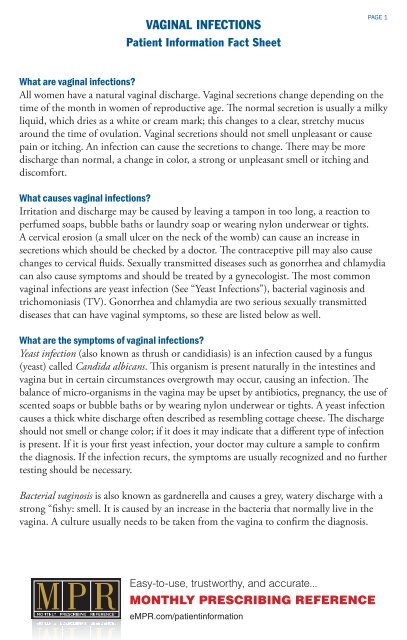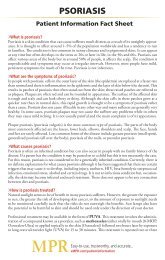VAGINAL INFECTIONS - MPR
VAGINAL INFECTIONS - MPR
VAGINAL INFECTIONS - MPR
Create successful ePaper yourself
Turn your PDF publications into a flip-book with our unique Google optimized e-Paper software.
<strong>VAGINAL</strong> <strong>INFECTIONS</strong><br />
Patient Information Fact Sheet<br />
PAGE 1<br />
What are vaginal infections?<br />
All women have a natural vaginal discharge. Vaginal secretions change depending on the<br />
time of the month in women of reproductive age. The normal secretion is usually a milky<br />
liquid, which dries as a white or cream mark; this changes to a clear, stretchy mucus<br />
around the time of ovulation. Vaginal secretions should not smell unpleasant or cause<br />
pain or itching. An infection can cause the secretions to change. There may be more<br />
discharge than normal, a change in color, a strong or unpleasant smell or itching and<br />
discomfort.<br />
What causes vaginal infections?<br />
Irritation and discharge may be caused by leaving a tampon in too long, a reaction to<br />
perfumed soaps, bubble baths or laundry soap or wearing nylon underwear or tights.<br />
A cervical erosion (a small ulcer on the neck of the womb) can cause an increase in<br />
secretions which should be checked by a doctor. The contraceptive pill may also cause<br />
changes to cervical fluids. Sexually transmitted diseases such as gonorrhea and chlamydia<br />
can also cause symptoms and should be treated by a gynecologist. The most common<br />
vaginal infections are yeast infection (See “Yeast Infections”), bacterial vaginosis and<br />
trichomoniasis (TV). Gonorrhea and chlamydia are two serious sexually transmitted<br />
diseases that can have vaginal symptoms, so these are listed below as well.<br />
What are the symptoms of vaginal infections?<br />
Yeast infection (also known as thrush or candidiasis) is an infection caused by a fungus<br />
(yeast) called Candida albicans. This organism is present naturally in the intestines and<br />
vagina but in certain circumstances overgrowth may occur, causing an infection. The<br />
balance of micro-organisms in the vagina may be upset by antibiotics, pregnancy, the use of<br />
scented soaps or bubble baths or by wearing nylon underwear or tights. A yeast infection<br />
causes a thick white discharge often described as resembling cottage cheese. The discharge<br />
should not smell or change color; if it does it may indicate that a different type of infection<br />
is present. If it is your first yeast infection, your doctor may culture a sample to confirm<br />
the diagnosis. If the infection recurs, the symptoms are usually recognized and no further<br />
testing should be necessary.<br />
Bacterial vaginosis is also known as gardnerella and causes a grey, watery discharge with a<br />
strong “fishy: smell. It is caused by an increase in the bacteria that normally live in the<br />
vagina. A culture usually needs to be taken from the vagina to confirm the diagnosis.<br />
Easy-to-use, trustworthy, and accurate...<br />
MONTHLY PRESCRIBING REFERENCE<br />
e<strong>MPR</strong>.com/patientinformation
Trichomoniasis is caused by a tiny parasite and is sexually transmitted. The symptoms<br />
start between four days and three weeks after contact with an infected person. It causes<br />
a thin, yellow or green discharge, which may be frothy and have an unpleasant “fishy”<br />
smell. Again, a vaginal swab is usually required to confirm the diagnosis. Sometimes<br />
there are no symptoms.<br />
PAGE 2<br />
Gonorrhea is caused by bacteria and is sexually transmitted. It may not always cause<br />
symptoms. If it does, the symptoms may be a sore throat, pain or discomfort when<br />
passing urine and a thin, watery, yellow or green vaginal discharge. It is not usually<br />
detected during cervical smear tests or routine health checks if there are no symptoms.<br />
If a sexual partner has gonorrhea, it is important for the other partner to be tested even<br />
if they do not have any symptoms. If symptoms clear up without treatment it is still vital<br />
for the infection to be treated. Gonorrhea can be cured with antibiotics but, there is<br />
increasing risk of antibiotic resistance. If symptoms do not improve with treatment, the<br />
patient should return to their doctor for reevaluation. Gonorrhea can spread inside the<br />
body and can cause pelvic inflammatory disease (PID) in women. PID can cause<br />
infertility. A gynecological exam is strongly recommended.<br />
Chlamydia is a sexually transmitted infection caused by bacteria called Chlamydia<br />
trachomatis. Infected persons often have mild symptoms or none at all. Most people<br />
do not get tested until complications arise. In those that do get symptoms, these usually<br />
occur around a month after infection and include pain or stinging when passing urine, a<br />
milky or mucus-like discharge, pain during sexual intercourse, bleeding between periods<br />
and stomach pain. If left untreated chlamydia can cause PID and may affect fertility. A<br />
vaginal culture is required to confirm the diagnosis.<br />
How are vaginal infections treated?<br />
A yeast infection is treated with antifungal creams that are applied locally to the area<br />
surrounding the vagina or with antifungal suppositories or cream inserted into the<br />
vagina. Often a combination of the two is used. Examples of topical antifungal agents<br />
used to treat yeast infections include clotrimazole, terconazole, miconazole and nystatin.<br />
Many treatments for yeast infections are available to buy from a pharmacy without a<br />
prescription.<br />
Treatment for bacterial vaginosis is with antiprotozoal-antibacterial tablets containing<br />
either tinidazole (Tindamax) or metronidazole (Flagyl). Metronidazole is also available<br />
as a vaginal gel called Metrogel. A cream containing clindamycin (Cleocin Cream) may<br />
also be prescribed.<br />
Easy-to-use, trustworthy, and accurate...<br />
MONTHLY PRESCRIBING REFERENCE<br />
e<strong>MPR</strong>.com/patientinformation
Trichomoniasis can also be treated with antiprotozoal-antibacterial tablets containing<br />
either tinidazole or metronidazole. Gonorrhea is treated with antibiotics using a<br />
combination of ceftriaxone (Rocephin) or cefixime (Suprax) plus azithromycin<br />
(Zithromax) or doxycycline (Vibramycin) given orally or as injections. Effective<br />
treatment will ensure a cure of this condition. Chlamydia is treated with antibiotics.<br />
The antibiotics usually prescribed include azithromycin (Zithromax) and doxycycline.<br />
Further information<br />
Centers for Disease Control and Prevention: www.cdc.gov/STD<br />
Last reviewed: August 2011<br />
PAGE 3<br />
Easy-to-use, trustworthy, and accurate...<br />
MONTHLY PRESCRIBING REFERENCE<br />
e<strong>MPR</strong>.com/patientinformation

















